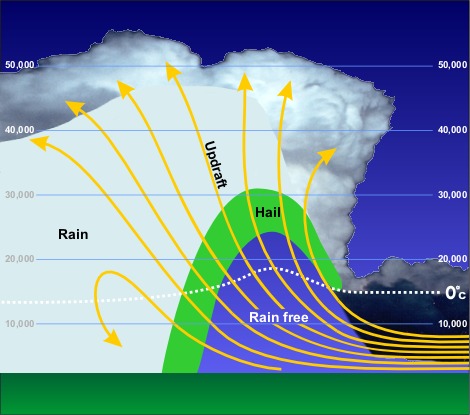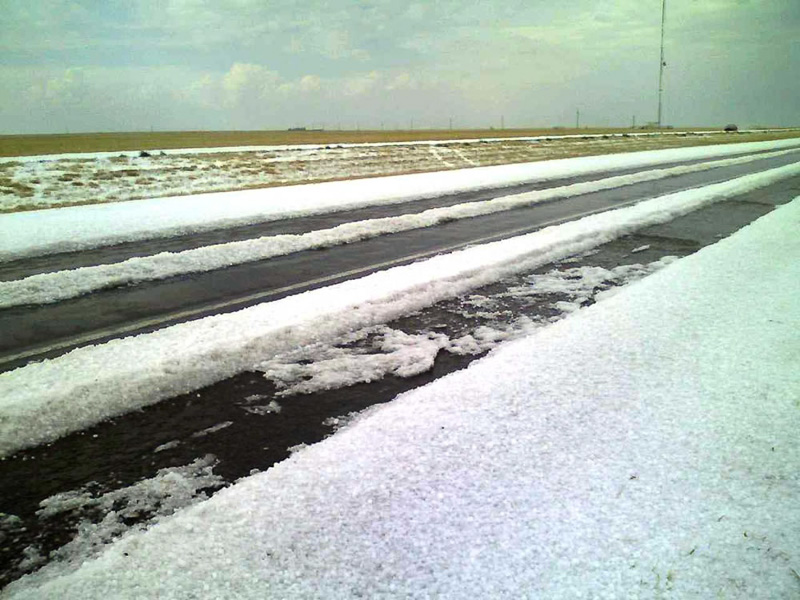Hail is one of the most fascinating and potentially dangerous forms of precipitation. These solid ice pellets, formed within the tumultuous updrafts of thunderstorms, can cause significant damage to property, vehicles, and even pose a deadly threat to humans and livestock. Let’s dive into the science behind hail, how it forms, and the impacts it can have, with a mention of Colorado, a state frequently pounded by these ice giants.
What is Hail?
Hail is a form of precipitation consisting of solid ice that forms inside the updraft of a thunderstorm. Unlike sleet or snow, hailstones can grow to significant sizes and fall at high speeds, causing damage to aircraft, homes, cars, and can be deadly to livestock and people.
How Does Hail Form?
Hailstones are created when raindrops are carried upward by thunderstorm updrafts into extremely cold areas of the atmosphere and freeze. As these frozen particles travel within the storm, they collide with liquid water droplets that freeze upon impact, causing the hailstone to grow. The structure of the hailstone can vary; if the water freezes instantaneously, it creates cloudy ice filled with air bubbles. If the water freezes more slowly, the resulting ice is clear.
A hailstone falls to the ground when it becomes too heavy for the updraft to support. During its journey, the hailstone may experience different temperatures and moisture conditions, leading to a layered structure of clear and cloudy ice.

How Does Hail Fall to the Ground?
Hailstones fall when their weight surpasses the strength of the thunderstorm updraft. Gravity pulls these ice pellets towards the earth. Smaller hailstones can be deflected by horizontal winds, leading to larger hailstones typically falling closer to the updraft. In strong surface winds, hail can even fall at an angle, which increases the potential for damage.

How Fast Does Hail Fall?
The fall speed of hailstones is influenced by their size, shape, and the atmospheric conditions they encounter. Smaller hailstones (<1-inch in diameter) fall at speeds between 9 and 25 mph. Hailstones measuring 1 to 1.75 inches in diameter fall between 25 and 40 mph. The largest hailstones, ranging from 2 to 4 inches, can fall at speeds between 44 and 72 mph, with some exceptional cases exceeding 100 mph.
Hail in Colorado
While Florida experiences the most thunderstorms, the states of Nebraska, Colorado, and Wyoming see the highest frequency of hailstorms, particularly in a region known as “hail alley.” This area averages seven to nine hail days per year, making Colorado one of the most hail-prone states in the country. The Front Range and Eastern Plains of Colorado are especially susceptible to these ice storms, often causing extensive damage to crops, vehicles, and homes.
How Large Can Hail Get?
The largest recorded hailstone in the United States fell in Vivian, South Dakota, on June 23, 2010. It had an astounding diameter of 8 inches, a circumference of 18.62 inches, and weighed nearly 2 pounds.
Estimating Hail Size
Hail sizes are often estimated by comparing them to common objects:
– Pea: 1/4 inch diameter
– Penny: 3/4 inch diameter
– Quarter: 1 inch (considered severe)
– Golf Ball: 1 3/4 inches
– Baseball: 2 3/4 inches
– Softball: 4 inches
– Grapefruit: 4 1/2 inches
By understanding hail and its dangers, you can better prepare and protect yourself, your loved ones, and your property from its potentially devastating effects. Stay informed, stay safe, and always heed weather warnings when they are issued.
